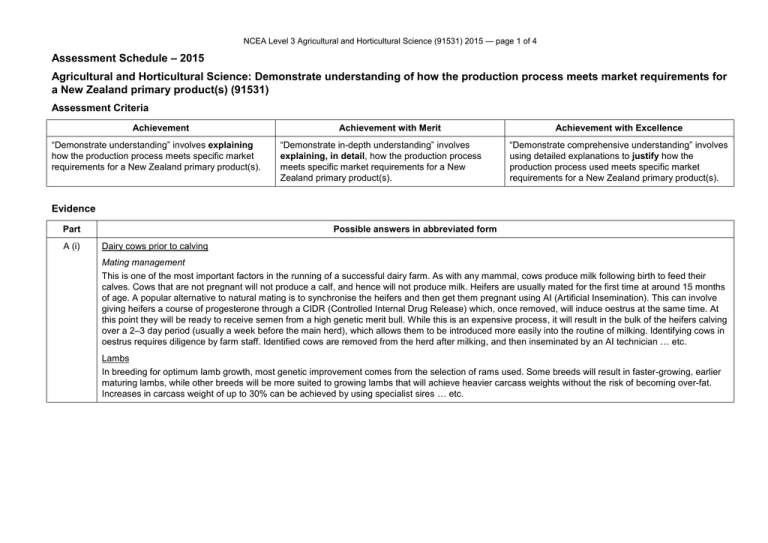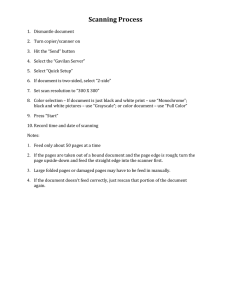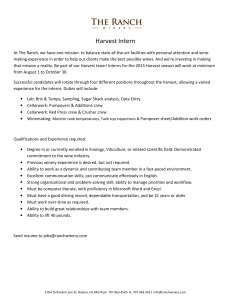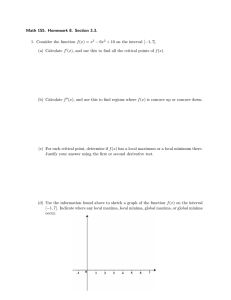– 2015 Assessment Schedule
advertisement

NCEA Level 3 Agricultural and Horticultural Science (91531) 2015 — page 1 of 4 Assessment Schedule – 2015 Agricultural and Horticultural Science: Demonstrate understanding of how the production process meets market requirements for a New Zealand primary product(s) (91531) Assessment Criteria Achievement “Demonstrate understanding” involves explaining how the production process meets specific market requirements for a New Zealand primary product(s). Achievement with Merit “Demonstrate in-depth understanding” involves explaining, in detail, how the production process meets specific market requirements for a New Zealand primary product(s). Achievement with Excellence “Demonstrate comprehensive understanding” involves using detailed explanations to justify how the production process used meets specific market requirements for a New Zealand primary product(s). Evidence Part A (i) Possible answers in abbreviated form Dairy cows prior to calving Mating management This is one of the most important factors in the running of a successful dairy farm. As with any mammal, cows produce milk following birth to feed their calves. Cows that are not pregnant will not produce a calf, and hence will not produce milk. Heifers are usually mated for the first time at around 15 months of age. A popular alternative to natural mating is to synchronise the heifers and then get them pregnant using AI (Artificial Insemination). This can involve giving heifers a course of progesterone through a CIDR (Controlled Internal Drug Release) which, once removed, will induce oestrus at the same time. At this point they will be ready to receive semen from a high genetic merit bull. While this is an expensive process, it will result in the bulk of the heifers calving over a 2–3 day period (usually a week before the main herd), which allows them to be introduced more easily into the routine of milking. Identifying cows in oestrus requires diligence by farm staff. Identified cows are removed from the herd after milking, and then inseminated by an AI technician … etc. Lambs In breeding for optimum lamb growth, most genetic improvement comes from the selection of rams used. Some breeds will result in faster-growing, earlier maturing lambs, while other breeds will be more suited to growing lambs that will achieve heavier carcass weights without the risk of becoming over-fat. Increases in carcass weight of up to 30% can be achieved by using specialist sires … etc. NCEA Level 3 Agricultural and Horticultural Science (91531) 2015 — page 2 of 4 A (ii) Feijoas Pruning Growers aim to achieve a compact, single-stemmed, multi-branched, round tree. Pruning may be required in many instances in order to achieve this, especially with certain cultivars or growing conditions. Most pruning is done in winter straight after harvesting, but a summer prune, once flowering is finished, will improve access at harvest and promote growth in the centre of the tree. Trees are limited to two metres, to allow for hand harvesting without the need for ladders. Branch thinning is required in order to enhance pollination and light penetration, thus increasing flowing in the centre, showing shoots … etc. Broiler chickens Feeding Regulating growth by feed can be done by adjusting feed quality in terms of nutritional value, the physical presentation of feed (pellet vs mash), or the quantity the birds are allowed to eat. Cereals provide energy, and soybean meal, blood and bone meal, or fishmeal act as protein sources. Two amino acids, lysine and methionine, are added, because chicken feed is deficient in these. The nature of the fat in the diet is monitored, otherwise fat deposits in the body can become more liquid than usual, producing “oily bird” syndrome. Protein sources are expensive, and in order to be cost-efficient, computerised programming of feed is essential. Some animal health products are also added, e.g. Coccidiostat. This is a chemical that supresses protozoa, which cause an infection called coccidiosis. If this infection is left uncontrolled, the birds develop a bloody diarrhoea and can die. The Coccidiostat should not be present in the meat, so growers stop feeding the chemical three days before slaughter. Pelleted feed … etc. Temperature and ventilation Air temperature is critical to bird performance in the early stages of growth. Like most warm-blooded animals, chicks are sensitive to cold and infection, so for the first two weeks of life they are placed under heat lamps. Initially the temperature should be 30°C, but after the heat lamps are turned off, the birds should be able to adjust to normal changes in temperature. The ideal temperature is 22°C. Chicks will huddle together and become stressed if cold, or spread out from the lamps if it is too hot. Both factors divert feed energy towards temperature regulation rather than meat production … etc. B All factors, including breed, stocking density, water management, temperature, ventilation, disease control, and feeding, contribute to the quality and quantity of broiler chickens at harvest. But arguably the most important factor is feeding, for both the quality and the quantity of broiler chickens. This is because regardless of the environment the birds are grown in (indoor, free-range), the feed influences the growth rate and quality of meat for sale more than other factors. Without correct feed … etc. Even though temperature is a key factor in the first two weeks of life, they can still maintain healthy growth rates if the correct feed mix is provided. Further, the feed can also contribute to the health of the animal, which ensures that a quality, disease-free product is available for sale … etc. Whilst ventilation … etc. Therefore I believe … for the following reasons, etc. NCEA Level 3 Agricultural and Horticultural Science (91531) 2015 — page 3 of 4 N1 No useful information about market requirements. A partial explanation of the effect of a management practice on the quality and quantity of a specific product at harvest, but it is not linked. N2 A3 A4 M5 M6 E7 E8 Some information about requirements. The requirements of the market are described in general terms. The requirements of the market are described in general terms. A basic (poorly linked) explanation of the effect of a relevant management practice on the quality and / or quantity of a specific product at harvest for each of the two periods: Establishment. Growth. An adequate explanation of the effect of a relevant management practice on the quality and / or quantity of a specific product at harvest for each of the two periods: Establishment. Growth. The requirements of the market are described, using specific details / data. The requirements of the market are described, using specific details / data. The requirements of the market are described, using specific details / data. The requirements of the market are described, using specific details / data. A sound and thorough (use of data OR well-linked) explanation of at least ONE of the TWO relevant management practices that have an effect on quality and quantity at harvest, for each of the TWO periods: Establishment. Growth. A sound and thorough (use of data AND welllinked) explanation of BOTH of TWO relevant management practices that have an effect on quality and quantity at harvest, for EACH of the TWO periods: Establishment. Growth. A sound and thorough (use of data AND welllinked) explanation of BOTH of TWO relevant management practices that have an effect on quality and quantity at harvest, for EACH of the TWO periods: Establishment. Growth. A sound and thorough (use of data AND welllinked) explanation of BOTH of TWO relevant management practices that have an effect on quality and quantity at harvest, for EACH of the TWO periods: Establishment. Growth. AND AND AND An adequate explanation for the second practice and / or period. A partial justification of a management practice that has the greatest effect on the volume of product at harvest, in terms of quality and / or quantity, but lacking detail / data OR no comparative manipulation. A full and comprehensive justification of a manage practice that has the greatest effect on the volume of product at harvest, in terms of quality and quantity, with relevant detail / data OR comparative manipulation. A partial explanation of the effect of a management practice on the quality and quantity of a specific product at harvest. N0/ = No response; no relevant evidence. NCEA Level 3 Agricultural and Horticultural Science (91531) 2015 — page 4 of 4 Cut Scores Not Achieved Achievement Achievement with Merit Achievement with Excellence 0–2 3–4 5–6 7–8




